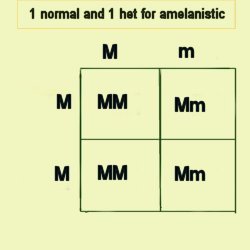Double "D" Reptiles
Home | Animals for Sale | Classifieds | About Us
The first case scenario is using 2 totally normal animals. We're posting this to basically show how the traits are expressed using the squares.



1 - normal offspring
2 - normal appearing offspring but het. for the trait
1 - albino offspring

2 - normal appearing offspring het for albino
2 - albino offspring
Now, just for the sake of arguement, we'll take a quick look at what happens when 2 animals, sharing the same recessive trait, are bred together. You should have figured the outcome by now, but rest assured, the offspring will all show the desired recessive trait, in this case, being albino.

Our first diagram shows how a genetically normal parent animal and a parent animal that is het. for both traits affect the offspring produced. We will use "A" for amelanistic, or regular albino and "B" for anytheristic, or what has sometimes been termed "black albino."

In the next drawing, we see how normal appearing parent animals, which are each heterozygous for a different recessive trait, have an impact on the offspring which are produced.

The 3rd scenario is using 2 normal appearing parent animals that are both double het. for the 2 recessive traits. If 16 offspring are produced, statistically we should have a 1:16 chance of getting our snow.

1 - completely normal animal (AABB)
2 - normal appearing and het for amelanistic (AaBB)
2 - normal appearing and het for anytheristic (AABb)
4 - normal appearing and het for both amelanistic and anytheristic (AaBb)
1 - Purely amelanistic (aaBB)
2 - Amelanistic and het for anytheristic (aaBb)
1 - Purely Anytheristic (AAbb)
2 - Anytheristic and het for amelanistic (Aabb)
1 - Snow - showing the combination of both recessive traits (aabb)
The 4th case scenario using 2 expressed traits is where we have 2 parent animals that express one recessive trait and are each het for the other recessive trait.

In the case of a snow crossed with a completely normal animal, let us just say that the offspring will all appear normal but be double het for both recessive traits.
In the scenario, let's use a snow, or double het animal and cross it with an animal that has one of the 2 recessive traits but is not heterozygous for the other trait. We won't draw this one out either, but rest assured that the offspring will all appear like the recessive parent and carry the het. gene for the other trait. So, a snow crossed with a pure amelanistic will produce offspring that all appear amelanistic but are heterozygous for anytheristic. The same happens if you switch the 2 traits.
In this last look at 2 traits expressed on seperate genetic markers in the DNA. We'll look at what happens when our snow morph is crossed with either an amelanistic or an anytheristic partner that is heterozygous for the other trait (in the case below we will use amelanistic though the outcome is the same for both.) As you should expect, there will be a high number of snow offspring in such a mating.
